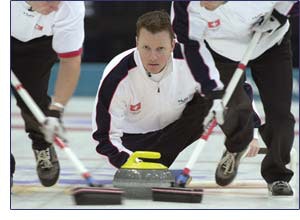New technology touches everything -- balls, bats, racquets, skates, even wheelchairs -- and can both advance sport and irrevocably alter it.
 Swiss curling team at the 2002 Winter Olympics
Swiss curling team at the 2002 Winter Olympics
Is the object simply to throw the javelin as far as a javelin can be thrown? Or are there other concerns -- containing throws within a stadium infield, ensuring valid throws in which the javelin hits the ground tip-first -- that are equal in weight? Should the rules reward brute strength over proper form, or vice versa?
The history of the javelin over the past half-century offers an object lesson in the importance of considering the effects of technological advancement on sport. In 1953, a hollow javelin was invented that increased its flight capability, though it tended to land horizontally, making judging difficult and boosting the number of invalid throws. In 1956, a retired discus thrower from Spain, Felix Erauzquin, utilized a discus-style spin and throw to top 90 meters and challenge the javelin world record -- at 49 years old.
After younger javelin throwers began putting world records and spectators at risk, the International Amateur Athletic Federation (IAAF) banned the technique. Style rules still enforced today regarding the run-up to a javelin throw are a direct result of Erauzquin's tinkering with tradition.
By the early 1980s, javelin throwers and manufacturers had applied principles of aerodynamics to the classical piece of sporting equipment. Through research and development, it was discovered that if the javelin were made lighter and its center of gravity moved back, and an athlete used a different throwing technique that took advantage of its heightened ability to sail, distance records could again be smashed. In 1983, American Tom Petranoff broke the world record by three meters with a throw of 99.72 meters, after which, just three weeks before the opening of the 1984 Olympics, Uwe Hohn of East Germany far surpassed Petranoff's world record with a soaring, 104.80-meter toss.
At the same time, the IAAF, fed up with the large number of throws declared invalid, began considering proposals whereby a shift forward in the javelin's center of gravity would be mandated. Coincidentally, a judges' tent was pierced at the 1984 Olympics, and the IAAF soon after changed javelin specifications, with the new rules put in place on April 1, 1986. Strength-oriented athletes, not finesse-oriented throwers, once again ruled the javelin roost, and the valid world record under the new rules dropped by 20 meters. The javelin now in use is designed to limit flight distance to approximately 90 meters -- though the current world record of 98.48 meters would suggest that the IAAF might once again be forced to go back to the drawing board.
Bigger, Better
Organized sport is rife with examples of equipment advances that have revolutionized (and fundamentally altered) the game in question. Some occurred so long ago that it is hard to remember, for example, what tennis was like before the introduction of first the aluminum and then the graphite composite racquet. Others are recent enough that it is possible to look back at, say, speedskater Dan Jansen's memorable gold medal in the 1,000 meters at the 1994 Olympics with a touch of wistfulness. Jansen's time was a then-world record of 1:12.43, and predated by about two years the widespread adoption of the clap skate, in which the blade is attached to the boot by a hinge in the front. By the end of the 1998 Winter Olympics in Nagano, Japan, every distance record achieved on classic fixed-blade skates had been shattered; the current world mark in the 1,000 meters is held by the Netherlands' Gerard van Velde, at 1:07.18.
What all equipment innovation has in common, from the standpoint of its effect on play, is that it tends to favor a particular group of athletes. In some cases, as with canoe and kayak, higher-tech equipment gives an edge to the athletes or teams that can afford to pay for it. In other cases, the edge is physical, with power hitters in tennis, for example, driving finesse hitters into extinction.
Given that ensuring a level playing field is a primary function of most sports organizations, it seems odd how often equipment innovation catches them by surprise. Nadine Gelberg, founder and president of Get Charged -- which produces programs and newsletters to get young people thinking about how technology impacts sports, and life -- believes this to be a major failing of most national governing bodies (NGBs).
"I think one of our biggest challenges as people is that we make a lot of passive decisions, and then we're kind of surprised as to where we've gotten," Gelberg says. "Whereas a governing body might debate eligibility-rules changes endlessly, many sport governing bodies have had no political discussion surrounding the technology that is used in sport."
The problem is rather obvious: It's hard to anticipate exactly what form the next high-tech revolution will take. That said, sports organizations can take a step in the right direction by considering not just design standards -- the head of the tennis racquet can be no bigger than "x" -- but also performance standards. If the racquet advances to the point at which serves exceed, say, 160 miles per hour, manufacturers have gone too far.
Stuart Miller, technical manager for the London-based International Tennis Federation, says it's easy to overstate the effect of technology on sports -- or, at least, to understate governing bodies' and athletes' ability to adapt to changes.
"Our rules with respect to racquets are relatively brief," he says.
"Sometimes we see racquets that we feel don't meet the rules of tennis and we say no to them, but by and large, all the ones you see in a store are reasonably consistent in terms of manufacture. They're made of broadly the same things, they're the same size, they're the same weight, they're strung the same way. In general, the vast majority of racquets meet the rules."
As for the widely held perception that tennis was irrevocably altered (and made boring and predictable) by high-tech racquets -- well, Miller doesn't see it. "If you go to Roland Garros or look at any clay court tournament, it's anything but too fast or too dull," Miller says. "Go back to the 1970s -- remember those 50-shot rallies and never-ending matches? I mean, if anybody tells me that that tennis was more exciting than what you see on current clay courts, I think that they're wrong."
The ITF carefully monitors such statistics as the number of aces in grand-slam events, to ensure that the game isn't getting too fast for the players. The number of aces, in fact, has started to decrease in recent years, suggesting that the athletes are adjusting to the higher speed -- and that critics are extrapolating a theorem based on one less-than-memorable match (the 1998 Sampras-Ivanisevic Wimbledon final can be pinpointed as the source of many "Tennis Is Deadly Dull" stories).
It is the athletes themselves, Miller suggests, whose high-tech equipment -- their muscular bodies -- is most responsible for the change in sports.
"There is no doubt that the players have developed physiologically, and they're better prepared for tournament play," he says. "Tennis, like most sports, is becoming much more dynamic. In baseball, people talk about aluminum bats, juiced balls and thin air, when all you need to do is look at the players today compared to players 20 years ago. They're bigger and stronger than any of the guys who came before them. They're better conditioned, they swing the bat faster, they hit the ball harder. There's good reason to believe that player development is making the major contribution to changes in the nature of sport -- and that applies to all sports. Even golfers -- these guys are working out now. There aren't as many out-of-shape golfers as there were."
The Edge
Golf is probably the highest-profile sport to confront what the javelin's caretakers faced in the 1980s. Improvements in athleticism and equipment (balls as well as clubs) have brought many par-5s within eagle range and led golf course operators to up their courses' yardage and move hazards back into play. Driving this particular train, though, isn't elite golfers, but recreational players and the equipment manufacturers from whom they purchase $2.5 billion in equipment annually in the United States alone.
It would be easy to imagine that an adversarial relationship exists between governing bodies (the presumed protectors of sport) and equipment manufacturers pushing the innovation envelope, but that is far from the case. On the whole, Miller notes, both have similar interests.
"Racquet manufacturers are trying to produce a product that people enjoy playing with and which, in that way, leads more people to play tennis. We want more people playing tennis, too. So in that respect we're entirely consistent," Miller says.
"However, the manufacturers have an additional goal of innovation to entice new buyers -- there always has to be something newer and better. And while part of that may be in the marketing of whatever product they have, part of that may also be in finding ways in which they can get as close to the edge of the rules as possible without stepping over the boundary."
But more than that, manufacturers don't produce equipment in a vacuum. On the contrary, equipment makers work closely with athletes (some of whom are the actual equipment innovators) and with national governing bodies -- two groups that have much to gain by finding a performance edge.
The U.S. Olympic Committee, for instance, formed the Sports Equipment and Technology Committee (SETC) in the early 1980s to close the technology gap suggested by American athletes' earning of more medals in lower-tech sports such as track than in higher-tech sports such as cycling. The objective, says Tanya Porter, head of performance technology at the USOC, was both to boost American athletes' performances and to make sure technological advances didn't skirt international standards.
"The SETC came into being to find anything that might help performance, especially with the innovation of new materials that could make equipment lighter, stronger or safer," Porter says. "We were given anywhere from $200,000 to $500,000 annually that we could award to makers of innovative equipment or developers of groundbreaking research with respect to sports performance."
Although the SETC is not formalized as a committee anymore, the USOC continues to award such grants and to help in the testing and validation of performance research, with grants offered through the organization's "performance pool." Money is given only to a particular sport's governing body for projects that target elite athletes, after the NGB has found an equipment manufacturer that can work up a prototype or develop a protocol for performance research. The clap skate, for example, was developed by the Dutch speedskating NGB, but was tested by U.S. Speedskating with the help of the SETC.
"USS got its engineers together and went to skate manufacturers for help in designing a clap skate for U.S. athletes, and then we got involved in testing the use of equipment and the interaction between the athlete and the equipment," says Porter. "With innovations like clap skates and high-tech swimsuits, all the top teams are quick to test them and have their athletes comfortable in them. It's a race."
The athletes who are arguably the quickest to embrace new technologies are also the ones for whom new technologies are arguably the most problematic: Paralympians. While the athletes that wield bats, racquets and irons sometimes talk about the equipment becoming almost an extension of their bodies, disabled athletes' prosthetic limbs and sport wheelchairs are a literal component of their movement as athletes.
A controversy that erupted at the 2004 Athens Paralympics had to do with a perceived laxity in enforcing limits on double amputees' leg length (a longer stride could obviously give an advantage to an improperly outfitted runner). Quad rugby has had its share of controversies, too, including one a decade ago in which athletes misused a sticky substance known by players informally as "red rubber," ostensibly meant to aid in gripping the chair's push rim. James Gumpert, the Quad Rugby USA coach, says the goop nearly brought the game to a literal halt.
"Our sport has high-pointers and low-pointers -- high-pointers' job is to stay away from low-pointers, and low-pointers' job is to hold the high-pointers," Gumpert explains. "Well, once low-pointers started putting it on their chairs, every time a high-pointer would run up against a low-pointer, he'd stick. There was not an answer that high-pointers could come up with for it. It was very frustrating for a long time."
The solution dreamed up by high-pointers -- Gumpert says most sport wheelchair innovations come from the players, not the manufacturers, who tend to design for day-to-day living rather than sport -- was to redesign chairs so that wheels were placed further and further inside the chairs' bumpers and guards.
"Whenever either group of athletes comes up with an advancement, usually the other will then come up with a counter," Gumpert says. "Over the past five or six years, it was happening every six months, and it was anywhere from a $500 to $1,000 change every time. So what is a competitive advantage in February probably isn't in June."
Moreover, Gumpert adds, the pace of innovation can't possibly continue at its present rate. "We're kind of reaching the outer limits of advancements," he says. "There's just not a whole lot more room left to go."
Ruling the Game
No doubt softball and baseball rules makers felt the same way when aluminum bats were first introduced. By now, however, it must be clear to everyone involved -- after several different recalls and retooling of various bats, and with circulated lists of legal and illegal bats now an annual ritual of recreational ball -- that there is no obvious stopping point for innovation.
Sports such as softball have a particularly difficult task in regulating equipment innovations because of the range of players that each successive improvement targets. Dee Abrahamson, senior women's administrator at Northern Illinois University and secretary/rules editor of the NCAA Softball Rules Committee, says that as a collegiate administrator she has the easiest time of it because all her athletes are 17 to 22 years old and female. The Amateur Softball Association, by contrast, has "fast-pitch, slow-pitch, modified pitch, 16-inch, boys', men's, girls', women's, youth and seniors, and it's trying to create equipment for that whole group," she says. "The U.S. Softball Association, same thing, from 5-year-olds to 80-year-olds. So when they talk to manufacturers about what their constituents want in a bat or a ball, it's a lot tougher." In addition, Abrahamson says, few of those distinct groups have access to statistics that might help them determine their equipment needs.
The NCAA does keep track of runs, hits and home runs per game, and has a pretty fair injury reporting system, as well, giving the rules committee a solid basis for tweaking its equipment requirements. Interestingly, however, where most of the other organizations (and NCAA baseball) have consistently tried to limit the performance of bats and balls for reasons of safety and "protecting the integrity of the game," collegiate softball administrators have more or less passed on the bat issue and put their energy into developing a harder ball that diminishes pitchers' dominance.
"We went from cork balls that had yarn around them to polycore balls, and now the latest thing on the market is higher-performing, multilayer balls," Abrahamson says. "We used to complain as coaches about the old cork balls, because the balls lost their integrity by about the fifth inning. You had to get a lead early because by the sixth or seventh inning, you couldn't shoot one out of a cannon to get it to go out of the park. We wanted manufacturers to give us a ball that would hold up, and they've done that. In the process, they've created a ball that will fly farther than the old balls. When it flies farther it also goes through the infield faster, which may have an effect on people getting hurt. So we do want to keep a handle on the situation so it doesn't go wherever manufacturers and technology would allow."
The process has required several tweaks along the way, Abrahamson notes, all in the interest of striking a balance between offense and defense, and out of concern for participants' safety. "At the beginning, we were pitcher-dominated to the point where if you got two people on base during a game you were feeling pretty good," she says. "But then, the higher-performing balls were taking the bruise out of the game, literally. When students were getting hit with balls, they weren't walking away with bruises, they were walking away with broken bones. We drove over one of those balls with a university bus and it didn't even get out of round. That tells you something."
NCAA specifications at the time didn't address compression, and the first compression standard it came up with amounted to squeezing a ball in a type of vice and measuring how much force would be required to squash the ball a quarter of an inch. Recently, however, the NCAA and the American College of Sports Medicine have begun discussions that they hope will result in a compression standard that better mimics what happens to a ball at the point of impact with a bat. "You don't slowly compress a softball when you hit it, you dynamically compress it, and that can lead to different results," Abrahamson says. "You can take balls that have exactly the same compression numbers, put them on the field, and they act differently. Some will fly a lot farther off the bat. If what we're calling the new dynamic stiffness standard gets adopted, I think we'll see more changes in balls."
International tennis, too, has given its regulation balls a keen look, though its purpose is primarily to keep recreational players happy rather than to address a competitive or safety issue at the game's elite levels. The ITF, for instance, created a high-altitude ball that is 6 to 8 percent larger than a standard ball, leading to increased aerodynamic drag. As its name suggests, its purpose is to allow for sea-level play at higher elevations, but the physics -- players have more time to react to an opponent's shot and return it -- has a number of positive effects.
"It's certainly not being used as widely as we would like right now, but nonetheless it's a tool that is beneficial in a number of ways," Miller says. "It's beneficial to people who are learning the game or older people, so they can spend more time hitting the balls than picking them up. My anticipation is that in the not-too-distant future it will be an option for introduction at the elite levels, if we get to the point where the game is becoming too fast."
Introducing a different ball would amount to heresy in the eyes of traditionalists in just about any sport, but Miller says tradition has to go out the window if technological innovation gets too far ahead of a sport. The only other options to changing the equipment, he notes, would be to change the field of play or the rules themselves.
"If you follow through to some kind of logical conclusion, you would have to manipulate the rules to make sure that the game remains fundamentally the same as the game that it is now, that we want it to be," Miller says. "What about restricting players to one serve? What about making them keep their foot on the court during the serve? Or making them serve from one meter back? Or raising the height of the net? We've looked at all of these in theory, and we feel that the change that offers the best long-term strategy and is the fairest across the spectrum of tennis players is to increase the size of the ball. There is definitely a balance to be struck."
And Now, The Future
DeMarini, a brand of Wilson Sporting Goods, is touting a bat it informally calls the "half and half" (and even less formally, the "bat that bends"), which features an aluminum alloy barrel fused to an ultralight carbon composite handle that flexes when swung. The possibility of similar technology coming to tennis was anticipated by the ITF, which has written into its rules that racquets "shall be free of any device which makes it possible to change materially the shape of the racket or to change the weight distribution." The ITF might even have been anticipating a company called Liquidmetal Technologies Inc., a developer of products made from amorphous alloys, materials that are characterized by a random atomic structure and that the company says are two to three times stronger than commonly used titanium alloys. In 2003, HEAD was the first racquet manufacturer to incorporate Liquidmetal technology, a step that garnered the racquet manufacturer accolades in Fortune magazine.
Nanotechnology, meanwhile, is all the rage. One nanotech company will soon offer a golf ball whose interior material shifts less as the ball spins, according to Buffalo-based NanoDynamics, decreasing the potential for hooks and slices no matter how badly the ball is hit. Carbon nanotubes, an engineered matrix of carbon molecules that creates a substance up to 100 times stronger than steel, at one-sixth the weight, may have applications as an upgrade from graphite composites in tennis racquets and golf-club shafts. Other technologies being put forward add magnets to help one particular prototype racquet head bounce back into shape after impact, position dimples around the frame to improve flexibility, or change the shape of the string holes. This last new wrinkle, according to Prince Sports, increases that racquet's sweet spot by 54 percent.
Miller doesn't know what to make of all this. Of the latter racquet innovation, he says, "Well, I haven't seen any evidence that supports that, but that doesn't mean it isn't true. It has clearly created some momentum for Prince in terms of sales, and good for them. But all tennis racquets are subject to the laws of physics, and that racquet is no exception."
Get Charged's Gelberg, who says she plays with a graphite racquet, feels for manufacturers of equipment for sports, such as baseball, where performance standards haven't been adequately developed and whose caretakers, she says, are "floundering on how to make rules to protect the game."
"You do want technological innovation," Gelberg says, "because it can reduce costs and can increase opportunities to participate. Manufacturers are at a disadvantage if they're spending money for research and development, spending to market their new products, and then these organizations can ban them after all this money has been invested."
And oftentimes, adds the USOC's Porter, not even the caretakers of a sport recognize that seemingly minor changes can have an enormous impact on the skills needed to play it, or on the sport's unique look and feel.
"Until you go down the path, you don't really know the impact," Porter says. "Look at curling after the advent of the bristle brooms that replaced corn brooms. The classic sound, that whap-whap-whap on the ice, is gone; now you don't hear anything, and some people say it's just not curling anymore. Plus, there's a performance issue -- it took a lot more effort with corn brooms, and now the athletes are able to sweep rocks harder and keep them straighter longer and make them curl easier. They changed the sport."
































